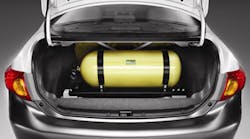Check your rear view mirror. That car zooming toward you may be fueled by natural gas — and it’s gaining fast.
Want proof? They were showing off a BMW X3 SUV, a Ford Mustang Coupe and even a family-friendly Ford Taurus powered by compressed natural gas, or CNG, in Southern California a few weeks ago. This road show of retrofitted vehicles, a project of an association of natural gas companies, is going national over the summer.
In the worthwhile journey to sustainability CNG-powered cars are the logical next leg.
About 70% of oil is burned for transportation, and it generates almost a third of greenhouse gases. CNG burns cleaner, significantly reducing emissions, including 90+% less carbon monoxide compared to gasoline.
Of course, we’re only in first gear when it comes to putting environmentally sustainable CNG-powered cars in every American driveway. Fleet and municipal vehicles are miles ahead, showing the rest of us the way. According to the Department of Energy, there are about 112,000 vehicles powered by natural gas in the U.S. — mostly buses, garbage trucks and delivery vehicles.
Yield: Nanotechnology Ahead
Nanotechnology will play an important role in our transportation conversion. In the longer term, I predict nanomaterials will be used for lightweight impact-resistant fuel tanks. As we invent the infrastructure for filling stations, there’s an opportunity to nano-engineer for more durable, efficient, reliable distribution systems, too.
For now, there’s one crucial area where nanotechnology is already up to speed: efficient, safe sustainable extraction. Natural gas extraction, including hydraulic fracturing, is going on in 31 states. The venues range from oil sands in the Dakotas to family farms in Pennsylvania. Everyone involved is concerned about protecting the environment — reflecting the same goals as vehicle developers.
Sustainability Starts at the Source
What’s ahead with nanotechnology for transportation? Get out your roadmap, and let’s take a trip of innovation.
One way nanotechnology is protecting the environment is by strengthening the pipes used for gas extraction.
These pipes run deep into the earth, well below the water table, and horizontally under acres of land. Drilling creates high heat, the slurry of sand and water used in extraction creates friction, and corrosive breakdown of pipes is a factor.
A company in my own Ohio backyard has developed nanocoatings to alleviate that corrosive deteriorationthat could create a seepage risk. Another nano-company I know has developed stable and environmentally benign lubricants formulated to boost the efficiency and lengthen the life cycle of drilling equipment under extreme pressures and heat.
There’s another group working focused on optimizing the amount of natural gas garnered from each site to reduce waste and increase output.
How? The network of fractures holding underground natural gas branch to ever smaller vessels.
With current technology, it’s difficult to judge when a reserve has been fully tapped. New nano-enabled “contrast agents” are being developed that will help drillers better visualize the full system. This means they can capture the maximum energy without unnecessary drilling impact.
Maintaining the environmental integrity of the site is also within the scope of nanotech’s innovation. Large volumes of water are produced during hyrdraulic fracturing and need to be contained and purified.
Nanotechnology is helping with both. A new nanocoating for the linings of containment ponds strengthens the barrier for an extra measure of groundwater protection.
Nanotechnology will also play a critical role in water purification going forward, as I recently wrote in a report on water purification for public officials. From nanoscale filter media to membranes laced with active nanomaterials, nanotechnology is revolutionizing water treatment. It offers better results at lower costs for a variety of contaminants.
Quite a joy ride, isn’t it?
Yes, we’ve still got a ways to go, but the road we need to take is clear. Natural gas is a smart, sustainable choice for fueling our cars, our economy and our future. And nanotechnology is the fuel for its development.



